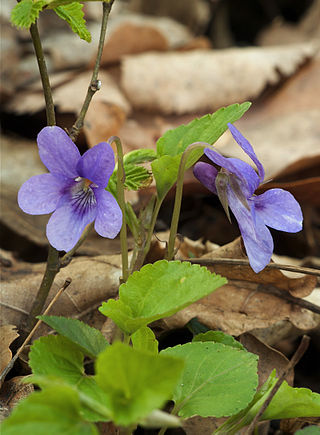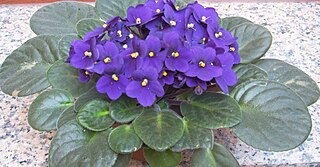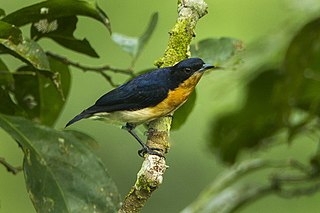
Viola is a genus of flowering plants in the violet family Violaceae. It is the largest genus in the family, containing between 525 and 600 species. Most species are found in the temperate Northern Hemisphere; however, some are also found in widely divergent areas such as Hawaii, Australasia, and the Andes.

Ovenbirds or furnariids are a large family of small suboscine passerine birds found from Mexico and Central to southern South America. They form the family Furnariidae. This is a large family containing around 315 species and 70 genera. The ovenbird, which breeds in North America, is not a furnariid – rather it is a distantly related bird of the wood warbler family, Parulidae.

The Agaricales are an order of fungi in the division Basidiomycota. As originally conceived, the order contained all the agarics, but subsequent research has shown that not all agarics are closely related and some belong in other orders, such as the Russulales and Boletales. Furthermore, DNA research has shown that many non-agarics, including some of the clavarioid fungi and gasteroid fungi belong within the Agaricales. The order has 46 extant families, more than 400 genera, and over 25,000 described species, along with six extinct genera known only from the fossil record. Species in the Agaricales range from the familiar Agaricus bisporus and the deadly Amanita virosa to the coral-like Clavaria zollingeri and bracket-like Fistulina hepatica.

The violet-green swallow is a small North American passerine bird in the swallow family. These aerial insectivores are distributed along the west coast from Alaska to Mexico, extending as far east as Montana and Texas. With an appearance very similar to the tree swallow, these individuals can be identified by the white rump side-patches that appear to separate their green back and purple tail. Violet-green swallows are secondary cavity nesters, found in a number of habitats including deciduous and coniferous forest. In addition to nesting in tree holes within these habitats, they are also widely observed nesting in the cracks of large cliffs.

Gesneriaceae, the gesneriad family, is a family of flowering plants consisting of about 152 genera and ca. 3,540 species in the tropics and subtropics of the Old World and the New World, with a very small number extending to temperate areas. Many species have colorful and showy flowers and are cultivated as ornamental plants.

Trimeresurus is a genus of venomous pit vipers found in Asia from the Indian Subcontinent throughout Southeast Asia, China, and the Pacific Islands. Currently 44 species are recognized. Common names include Asian palm pit vipers, Asian lanceheads, and green pit vipers.

Streptocarpus sect. Saintpaulia is a section within Streptocarpus subgenus Streptocarpella consisting of about ten species of herbaceous perennial flowering plants in the family Gesneriaceae, native to Tanzania and adjacent southeastern Kenya in eastern tropical Africa. The section was previously treated as a separate genus, Saintpaulia, but molecular phylogenetic studies showed that it was nested within the genus Streptocarpus.

The violet-crowned hummingbird is a hummingbird in the "emeralds", tribe Trochilini of subfamily Trochilinae. It is found in Mexico and the southwestern United States.

Tachycineta is a genus of birds in the swallow family Hirundinidae. There are nine described species all restricted to the Americas.

Chlorestes is a genus of hummingbirds.

Goldmania is a genus in the family of Hummingbirds, and consists of 2 species.

Woodnymphs are hummingbirds in the genus Thalurania. Males are green and violet-blue, while females are green with white-tipped tails and at least partially whitish underparts. Both sexes have an almost straight, entirely black bill and little or no white post-ocular spot. They are found in forest and tall second growth. The species in this genus are almost entirely allo- or parapatric, and a species is present virtually everywhere in the tropical humid Neotropics.

The hyliotas are a genus, Hyliota, of passerine bird from Africa. The taxonomic position of the genus has been a longstanding mystery. They have been formerly regarded as Old World warblers in the family Sylviidae, or related to the batises and wattle-eyes in the family Platysteiridae, bush-shrikes in the family Malaconotidae, or even Old-World flycatchers in the family Muscicapidae. An analysis of the mitochondrial DNA of the genus and possible relatives found they have no close relatives and are basal in the clade Passerida. They are now often regarded as a family in their own right, Hyliotidae.

Calvitimela is a lichen genus in the family Tephromelataceae. Members of the family Tephromelataceae are crustose lichens with green photobionts and lecideine or lecanorine apothecia. The species in Calvitimela have lecideine apothecia, are saxicolous and are primarily found in alpine to arctic regions.
Hammondia is a genus of parasitic alveolates in the phylum Apicomplexa.

Mycoblastus is a genus of crustose lichens in the family Tephromelataceae. Members of the genus are commonly called blood lichens.

The Tephromelataceae are a family of lichenized fungi in the order Lecanorales. The family was circumscribed by Austrian lichenologist Josef Hafellner in 1984. Tephromelataceae comprises the genera Tephromela, Calvitimela, Mycoblastus and Violella, which together constitute a well-supported monophyletic group.

Granatina is a genus of small seed-eating birds in the family Estrildidae that are found in Africa.

Ramosomyia is a genus in family Trochilidae, the hummingbirds, that was created in 2021 to replace Leucolia.
Violella wangii is a widespread, but seldom-collected species of crustose lichen in the family Tephromelataceae. Found in mountainous areas of Bhutan, China, India and the Russian Far East, it was formally described as a new species in 2011 by lichenologists Toby Spribille and Bernard Goffinet. The type specimen was collected from Laojunshan Mountain in the Shennongjia Forestry District at an altitude between 3,510 and 3,900 m ; there, in a montane forest of mostly Abies and Rhododendron, it was found growing on the bark of Rhododendron. In the Russian Far East, it has been recorded growing on the wood of Pinus pumila. Thin-layer chromatography of collected specimens showed the presence of three lichen products: atranorin, roccellic acid, and angardianic acid. The species epithet wangii honours Dr. Wang Li-Song, "for his ongoing efforts to describe the lichen diversity in western China".

















